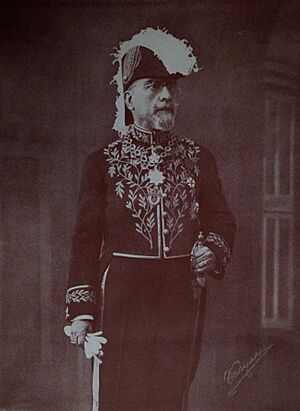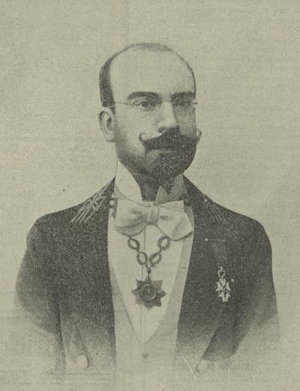António Cabreira facts for kids
Quick facts for kids
António Cabreira
|
|
|---|---|
 |
|
| Born |
António Tomás da Guarda Cabreira de Faria e Alvelos Drago da Ponte
30 October 1868 Santa Maria, Tavira, Portugal
|
| Died | 21 November 1953 (aged 85) |
| Occupation | Polygraph |
| Signature | |
António Cabreira (born October 30, 1868 – died November 21, 1953) was a very smart Portuguese man. He was a mathematician, which means he studied numbers and shapes. He was also a polygraph, which means he wrote about many different subjects. He was a publicist, too, sharing his ideas with others.
António Cabreira came from an important family called Cabreira. He used the noble titles of Count of Lagos and Viscount of Vale da Mata. He is famous for writing many books and papers on a huge variety of topics. These included mathematics, geometry, astronomy, literature, art, history, and archaeology. He even tried to solve old math problems like "squaring the circle"!
He also helped start many important groups that studied different subjects. Two of the most important were the Academy of Sciences of Portugal (started in 1907) and the António Cabreira Institute (started in 1919).
Contents
Early Life and School
António Cabreira was born in Tavira, Portugal, on October 30, 1868. His family home was on the corner of Rua Borda de Água de Aguiar and Rua da Alegria. These streets were later renamed Rua Jacques Pessoa and Rua Dr. António Cabreira.
His father was General Tomás António da Guarda Cabreira. His mother was D. Francisca Emília Pereira da Silva. António's grandfather, also named Tomás António da Guarda Cabreira, was a military leader. He was given the titles of Count of Lagos and Viscount of Vale da Mata. António also had an older brother, Tomás Cabreira, who became a politician and taught Chemistry.
António was baptized in the Church of Saint Mary of the Castle in Tavira. As a child, he was taught by a priest named Fr. Francisco de Paula da Fonseca Neves. When he was 12, he stopped his studies to travel with his father. His father was a lieutenant colonel in the army.
In 1885, at age 17, António went to school in Faro. From 1887 to 1889, he studied in Lisbon. When he was 21, he wanted to join the military like his father and grandfather. However, doctors said he was not strong enough. So, he started studying marine engineering at the Lisbon Polytechnic School.
Around this time, he also became involved in politics. He joined a political group called the Legitimist Party. He quickly became a leader and helped students with their problems. In 1891, he became the Political Editor for A Nação, a newspaper for his party.
His Work in Science and Learning
In 1894, António Cabreira started a school called the Instituto Dezanove de Setembro. This school offered classes for both younger and older students. At first, Cabreira managed the school. Later, in 1899, he began teaching subjects like mechanics and the philosophy of mathematics.
After a big event in 1890 that made many Portuguese people feel very patriotic, António Cabreira became active in the Lisbon Geographic Society. He strongly supported Portugal's efforts to have colonies around the world.
In the 1890s, António Cabreira started publishing his many writings. These showed his new ideas in mathematics, philosophy, and sociology. Some of his early works included "Geometric Analysis of Two Parabolic Spirals" (1895) and "On the Geometric Properties of Poinsot's Spiral" (1896). In 1896, the Geographic Society praised his first works as "scientific successes."
He was chosen to be a member of important academies in Portugal and France.
- On March 18, 1897, he became a member of the Royal Academy of Sciences in Lisbon.
- He also became a foreign member of the Academy of Sciences in Toulouse, France.
- Later, he joined other academies in Montpellier and Dijon (France), Venezuela, Barcelona (Spain), and Naples (Italy).
He received an honorary doctorate degree in Mathematics from the University of Arizona in 1912. In 1933, he received a Medal of Honour from the University of Amsterdam.
In 1907, António Cabreira started a new group called the Academy of Sciences of Portugal. This was a rival to the older Lisbon Royal Academy of Sciences. Cabreira believed in a strong monarchy and did not like the way the old monarchy was declining. His new Academy even got support from some republican leaders who also opposed the old government.
After the 1910 Revolution, when Portugal became a republic, the new government approved Cabreira's Academy. They wanted it to be an official academy. However, over time, it became less important.
Still, Cabreira's Academy grew by adding "Annexed Institutes." These institutes aimed to spread the Academy's "patriotic and educational work" across the Portuguese world.
- The Instituto Teofiliano (started in 1912) studied the work of Teófilo Braga, a famous writer and politician.
- The Instituto de Trabalhos Sociais (started in 1914) helped Portuguese matchmakers compete with foreign products.
- The Instituto Arqueológico do Algarve (started in 1915) focused on studying old things in the Algarve region.
- The Instituto Histórico do Minho (started in 1916) studied history in the Minho region.
- The Instituto António Cabreira (started in 1919) was named after Cabreira himself. It aimed to study and share his important work.
- Other institutes included the Trás-os-Montes Scientific and Literary Institute, the Alentejo Historical and Archeological Institute, and the Beira Alta/Viseu Ethnological Institute.
António Cabreira also organized important meetings. He held the First Colonial Congress in 1900 and the First National Pedagogical Congress in 1908. In 1920, he hosted the First National Archaeological Congress in Tavira. This meeting was important because it pushed for more archaeological digs across the country. It also called for protecting old historical sites.
Death and Legacy
António Cabreira passed away in Lisbon on November 21, 1953. He was buried in his family's plot in the Municipal Cemetery in Tavira. His parents and brother were also buried there.
The large tomb is decorated with the family's coat of arms. It also has symbols like lions, armillary spheres, and crosses from military orders. An inscription on the back of the monument says:
EIS UM MOIMENTO DIGNO E QUE A SAUDADE ERGUEU
PARA REPÔR NA MORTE O MEU DESFEITO LAR
JULHO 5 DE 1928
("Behold a dignified monument that longing built / to set right, in death, my broken home / 5 July 1928")
The tomb was officially opened on July 5, 1928. Many important people attended, including representatives from the government and the military.
A statue of António Cabreira was put in the Public Park in Tavira in 1944. Cabreira himself was there for the unveiling. In 1942, he gave the house where he was born to the Tavira City Council. It is now used as the Municipal Archive. He also left his personal papers and study furniture to the Lisbon Geographic Society.
Distinctions
National orders
 Commander of the Military Order of Saint James of the Sword (May 17, 1919)
Commander of the Military Order of Saint James of the Sword (May 17, 1919)
Foreign orders
 Knight of the Legion of Honour, France (January 8, 1903)
Knight of the Legion of Honour, France (January 8, 1903) First Class of the Order of Merit, Chile (June 29, 1922)
First Class of the Order of Merit, Chile (June 29, 1922)
Confraternal orders
António Cabreira also helped start the Order of Saint Mary of the Castle. This group was created on December 20, 1921. Its main goals were to honor the memory of Paio Peres Correia, a knight who helped take back the city of Tavira in 1242. The Order also aimed to protect the Church of Saint Mary of the Castle.
António Cabreira was a descendant of Paio Peres Correia, so he had the rank of "Knight of Honour" in the Order. The government and church leaders approved the Order's rules. However, by 1947, the Order was not very active, and the government had stopped its use in official events.
Images for kids




